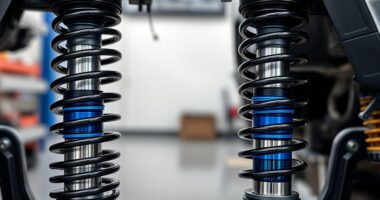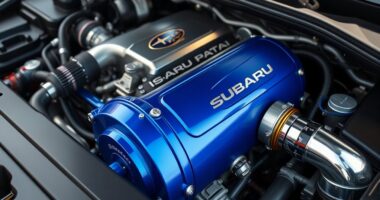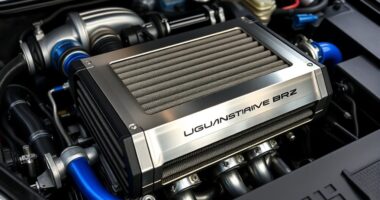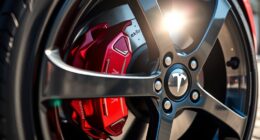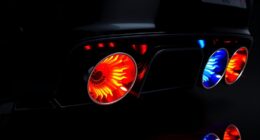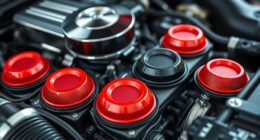After lowering your Subaru, you need to realign and recalibrate the EyeSight system to guarantee it functions properly. Begin by inspecting the sensor mounts and camera positions to confirm they’re level and aligned according to Subaru’s specifications. Use calibration routines with specialized tools or at a dealership to run proper adjustments. Regular updates and checks are key to maintaining safety features. Keep going to discover detailed steps that will help you get your system back to ideal performance.
Key Takeaways
- Inspect and realign the front sensors and stereo cameras to Subaru’s specified positions after lowering.
- Use a calibration target or run the vehicle’s calibration mode via Subaru’s Techstream or compatible diagnostic tools.
- Update the vehicle’s software to the latest version to ensure compatibility and optimal system performance.
- Perform a calibration routine at an authorized Subaru dealership or certified service center.
- Verify sensor alignment and system functionality periodically, especially after physical modifications or adjustments.

If you’ve ever experienced issues with your Subaru’s EyeSight system, you know how important proper calibration is for safe and reliable driving. When you lower your vehicle, it can disrupt the sensor alignment, which is essential for the EyeSight system to function correctly. Proper sensor alignment ensures that the stereo cameras and sensors are positioned accurately, allowing the system to detect vehicles, pedestrians, and obstacles as intended. If the sensors are misaligned after lowering, the system might give false alerts or fail to warn you about hazards altogether. To prevent this, you need to re-establish the correct alignment, which often involves adjustments to the camera mounting or sensor positioning.
Proper calibration of Subaru EyeSight is crucial after lowering to ensure accurate obstacle detection and safe driving.
In addition to physical adjustments, software updates play an important role in maintaining peak EyeSight performance after modifications like lowering. Subaru periodically releases updates that enhance system accuracy, fix bugs, or improve compatibility with aftermarket modifications. Making sure your vehicle’s software is up to date can help the system better interpret sensor data, especially if hardware adjustments have been made. Many Subaru dealerships or authorized service centers can perform these updates during routine maintenance, but some owners choose to do it themselves if they have the right tools.
When tuning your EyeSight system after lowering, start by inspecting the sensor mounts and camera positions. If your vehicle has been lowered, the sensors might be pointing slightly downward or misaligned from their original factory positions. Use a level or specialized calibration tools to confirm proper alignment. If you find that the sensors aren’t correctly aligned, carefully reposition or recalibrate them according to Subaru’s specifications. This process often involves using a calibration target or a specific calibration mode in the vehicle’s diagnostic system.
After physically adjusting the sensors, updating the system’s software ensures that the EyeSight system recognizes the new position and functions properly. Some software updates include calibration routines that can be run through Subaru’s Techstream software or a compatible diagnostic tool. Running these routines helps the system recalibrate its internal parameters, reducing false alerts and improving detection accuracy. Remember, calibration is not a one-time task; it’s essential to verify and recalibrate periodically, especially after modifications or if you notice irregular system behavior. Additionally, understanding the importance of vetted safety features can help you maintain optimal system performance and safety standards.
Frequently Asked Questions
How Long Does Eyesight Calibration Adjustment Typically Take?
The calibration adjustment for your EyeSight system usually takes about 30 minutes to an hour. You’ll need to guarantee proper sensor alignment using specialized calibration tools, which can affect the process’s duration. During this time, the system recalibrates to accurately monitor obstacles and maintain safety. It’s best to have a professional handle this, as precise calibration is essential for peak system performance and safety.
Can I Recalibrate Eyesight Myself at Home?
You might think DIY calibration is a simple fix, but don’t be fooled. EyeSight sensors require precise adjustments that only trained technicians can handle. Attempting DIY calibration using basic sensor adjustment techniques can lead to inaccurate readings and safety issues. Instead, trust professionals who have the right tools and expertise. Your safety and your Subaru’s performance depend on proper calibration—so skip the home repairs and visit a certified service center.
Will Lowering My Subaru Affect Warranty Coverage for Eyesight?
You might worry that lowering your Subaru affects your warranty implications for EyeSight, but it depends on dealership policies. Some dealerships may view modifications as voiding warranty coverage, while others are more lenient if the work is done professionally. To avoid issues, check your dealership’s specific policies before making modifications. Keep in mind, unauthorized adjustments could lead to complications with warranty claims, so always confirm beforehand.
Are There Risks of Damaging the Eyesight System During Calibration?
You’re wondering if calibrating your Subaru’s EyeSight system risks damage. During calibration, improper sensor alignment can lead to faulty readings, so it’s essential to use proper calibration tools and follow precise procedures. Incorrect adjustments might misalign sensors, causing system errors or malfunctions. To avoid damage, have a trained technician handle calibration, ensuring sensors are correctly aligned and the system functions accurately. This minimizes risks and maintains your EyeSight’s reliability.
How Often Should I Recalibrate Eyesight After Lowering My Vehicle?
Imagine your car’s sensors as the eyes of a hawk, sharp and precise. After lowering your vehicle, you should recalibrate your EyeSight system whenever you notice alignment issues or warning lights. Typically, check and recalibrate every 6-12 months, but more often if you’ve hit rough terrain or experienced an accident. Proper sensor positioning guarantees your system functions flawlessly, keeping safety sharp and reliable on every drive.
Conclusion
Now that you’ve adjusted your Subaru’s EyeSight calibration after lowering, remember: precision is key. Just like a finely tuned instrument, your system needs to be spot-on to work seamlessly. Don’t settle for anything less than perfect—your safety depends on it. With patience and careful calibration, you’ll restore your EyeSight’s clarity, ensuring every drive remains smooth, safe, and confident. After all, isn’t peace of mind worth the effort? Keep tuning, keep trusting.



